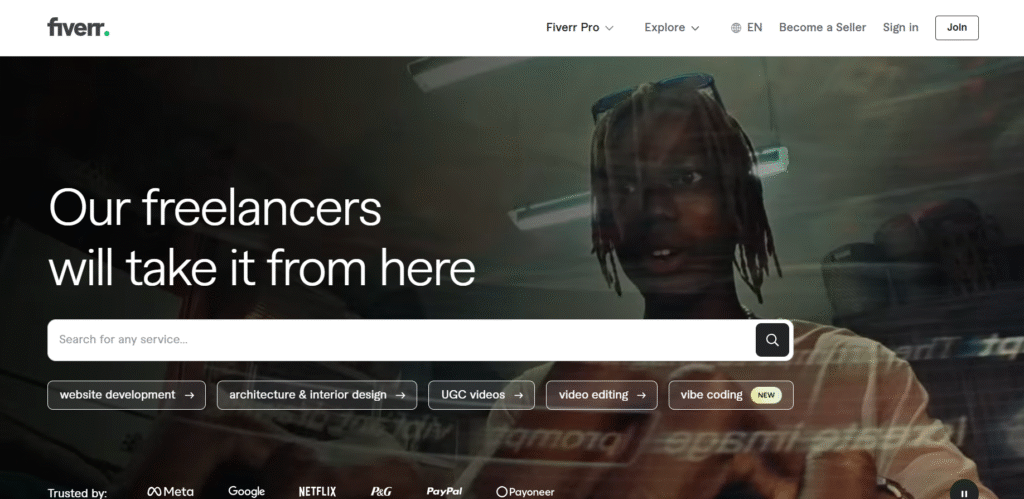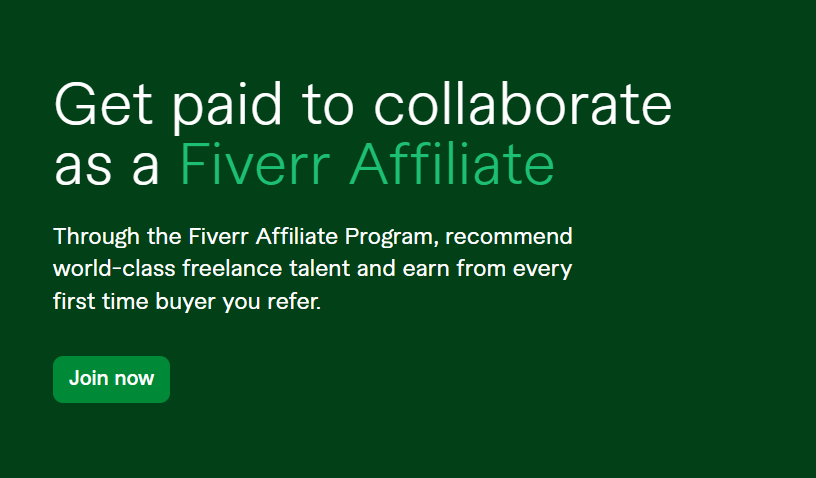Fiverr Affiliate Program: How To Make Money With It
Looking to monetize your blog, YouTube channel, or social media following? The Fiverr affiliate program offers multiple commission structures that let you earn from one of the world’s largest freelance marketplaces. Whether you’re promoting web development gigs or content writing services, Fiverr’s flexible payout options make it accessible for beginners and profitable for experienced marketers. Here’s everything you need to know to start earning.

Quick Program Stats
💰 Commission: $15-$150 CPA (category dependent) OR 30% revenue share for lifetime
🍪 Cookie Duration: 30 days
💳 Payment Terms: Monthly via PayPal, bank transfer, or Fiverr Revenue Card
🎯 Minimum Payout: $100
⏱️ Approval Time: Typically 24-48 hours
Why the Fiverr Affiliate Program Actually Makes Sense
Most affiliate programs force you to choose between upfront CPA payments or long-term revenue share. Fiverr gives you both, plus two additional earning models.
Here’s the real opportunity: Fiverr processes millions of transactions monthly across 300+ service categories. That means no matter what niche you’re in, there’s a relevant angle. Tech blogger? Promote web development and app creation gigs. Running a marketing site? Push social media management and SEO services.
The math gets interesting when you stack commission types. Promote a web programming service and you earn $30 CPA when someone makes their first purchase. Choose revenue share instead and you get 30% of every transaction that buyer makes on Fiverr for life. A freelancer spending $500 monthly nets you $150 every single month.
But here’s where most affiliates miss the boat: the hybrid model. You take a smaller $10 CPA upfront plus 10% revenue share. Lower initial payout, sure, but you’re building recurring income while still getting something immediately.
Understanding Fiverr’s Four Commission Models
Fiverr doesn’t lock you into one earning structure. You pick what works for your traffic and audience.
Revenue Share (30% Lifetime)
This is the long game. Every time your referred user buys anything on Fiverr, you get 30% of Fiverr’s service fee. Not 30% of the total transaction, but of Fiverr’s cut, which typically runs 20% of the gig price. So on a $100 gig, Fiverr takes $20 and you get $6. Doesn’t sound like much until you realize that buyer might spend $2,000 over the next year. Now you’re looking at $120 from one referral.
Best for content creators building audiences who’ll need ongoing freelance services, like agency owners, startup founders, or small business owners.
CPA (Cost Per Acquisition)
Straight cash for qualified first purchases. The payout varies wildly by category. Mobile app development pays $40. Web programming gets you $30. Graphics and design services pay $15. Writing and translation clock in at $30.
The key word is “qualified.” Fiverr defines this as a first-time buyer spending a minimum amount in each category. That threshold isn’t publicly disclosed but typically ranges from $10-$50 depending on the service.
Best for affiliates running paid traffic who need immediate ROI to reinvest in campaigns.
Hybrid ($10 CPA + 10% Revenue Share)
The middle ground. You get $10 when your referral makes their first purchase, then 10% of Fiverr’s fees on every future transaction. This smooths out cash flow while building passive income.
Think of it like getting paid to build a rental property. The $10 CPA covers your immediate costs while the 10% creates the recurring revenue stream.
Best for affiliates with consistent traffic who want to balance short-term cash flow with long-term earnings.
Sub-Affiliate (10% of Referred Affiliate Commissions)
Recruit other affiliates and earn 10% of whatever they make, forever. If you refer an affiliate who earns $1,000 monthly, you pocket $100 without doing their work.
This is pure leverage but requires an audience of marketers or content creators. Not viable for most affiliates starting out.
Best for affiliate marketing educators, digital marketing agencies, or anyone with access to aspiring affiliates.
How to Actually Promote Fiverr and Make Money
Skip the generic “freelancer marketplace” angle everyone uses. That’s a saturated battlefield. Instead, target specific buyer personas with high-value service needs.
The Startup Founder Angle
Create content around “How to Launch a SaaS Product for Under $5,000” or “Build Your MVP Without a Technical Co-Founder.” Walk through each step, recommending specific Fiverr gigs for development, design, and marketing. Your affiliate links are solutions to concrete problems, not random recommendations.
Traffic sources: Reddit (r/startups, r/entrepreneur), Indie Hackers, Product Hunt discussions, YouTube tutorials on lean startups.
The Content Creator Angle
Target YouTubers, podcasters, and TikTokers who need thumbnail designers, video editors, or SEO specialists. Content like “How I Scaled to 100K Subscribers Using Fiverr Freelancers” or “5 Fiverr Gigs That Doubled My Video Views.”
Traffic sources: YouTube (making money online, content creation niches), Twitter threads on creator economy, TikTok videos showing before/after of professionally edited content.
The Small Business Owner Angle
Local businesses need websites, social media management, and advertising creative but can’t afford full-time staff. Create comparison content like “Fiverr vs Hiring an Agency: $500 vs $5,000 for a Business Website.”
Traffic sources: Google search for “affordable logo design,” “cheap website for small business,” Facebook groups for local business owners, LinkedIn articles.
The SEO Gold Mine
Fiverr has terrible brand awareness outside of freelancers. That means tons of people searching for services don’t realize Fiverr offers them. Target keywords like “hire WordPress developer,” “affordable logo designer,” “freelance video editor” with comparison posts or directory-style pages.
Build landing pages targeting “[Service] for [Industry]” patterns. “Logo Design for Restaurants,” “Video Editing for Real Estate Agents,” “Content Writing for SaaS Companies.” Rank these pages, send traffic to curated Fiverr gig collections.
Traffic sources: Organic Google search, SEO-optimized blog content, niche directories.
The Paid Traffic Play
Facebook and Google ads work if you target high-value categories and use revenue share or hybrid models. You’re not profitable on Day 1, but if you’re bringing in buyers who’ll spend $200+ monthly on services, the lifetime value makes it work.
Run ads targeting specific pain points: “Need a Website Built This Week?” or “Get Your Business Logo Designed Today.” Send them to a landing page reviewing 3-5 top Fiverr sellers in that category with your affiliate link.
Budget $300-500 for testing. Track which service categories convert best, then scale those campaigns. Most affiliates fail here because they promote Fiverr generically instead of specific high-value services.
What Most Affiliates Get Wrong About Fiverr
The biggest mistake is treating Fiverr like Amazon. Just slapping affiliate links everywhere and hoping for commissions. That doesn’t work because people don’t browse Fiverr recreationally. They come with a specific need.
Your job is to intercept them earlier in their buyer journey. Before they know Fiverr exists.
Second mistake: promoting low-ticket gigs. A $5 logo design might convert well but generates pennies in commission. Focus on services where buyers typically spend $50-500+. Web development, mobile apps, business consulting, comprehensive branding packages.
Third mistake: ignoring the revenue share model. Most affiliates grab the CPA because it’s immediate money. But if you’re driving quality traffic—people actually starting businesses or running companies—those buyers will use Fiverr repeatedly. One good referral can be worth $500+ annually on revenue share.
The Honest Challenges Nobody Mentions
Fiverr’s brand is somewhat devalued in professional circles. Mention you hired someone on Fiverr and people assume cheap, low-quality work. That perception fight makes promoting it harder when targeting serious businesses.
The minimum payout threshold of $100 means beginners might wait months for their first payment. If you’re earning $5-10 weekly, that’s a long runway before seeing cash.
Competition is brutal in obvious niches. Every marketing blog has a “best freelance marketplaces” post with Fiverr links. You need specific angles to stand out.
The 30-day cookie is decent but not great. If someone clicks your link, gets distracted, and signs up 31 days later, you get nothing. Compare that to some programs offering 90-day or even lifetime cookies.
Category-specific CPA rates aren’t transparent upfront. You won’t know exactly what you’ll earn until you drive conversions and check your dashboard. Makes planning campaigns harder.
Who This Program Actually Works For
You’re a good fit if you:
- Have an audience of entrepreneurs, small business owners, or content creators
- Can create content around specific services or business problems
- Understand SEO and can rank for service-specific keywords
- Have budget for paid traffic and patience to optimize for lifetime value
- Can commit to promoting consistently for 3-6 months to build meaningful revenue
Skip this program if you:
- Only have a personal blog about random topics with no business angle
- Need immediate high commissions to pay bills next month
- Can’t create content showing specific use cases for freelance services
- Don’t have time to build content assets or run traffic campaigns
- Want a set-it-and-forget-it passive income stream
Getting Started the Right Way

Sign up through Fiverr’s affiliate platform (link below). Approval typically happens within 24-48 hours unless you have a brand new website with zero content.
While waiting for approval, identify your angle. Don’t promote “Fiverr” as a platform. Promote solutions to specific problems that Fiverr sellers solve. Make a list of 10 services your audience actually needs.
Build one piece of content per service. Could be a blog post comparing top sellers, a YouTube video showing a service being delivered, or a Twitter thread on how you used that Fiverr category to solve a business problem.
Choose your commission model based on your traffic. If you’re running paid ads and need immediate ROI, go CPA on high-value categories. If you’re building organic SEO content that’ll rank for years, take revenue share. If you’re unsure, hybrid splits the difference.
Track everything. Fiverr’s dashboard shows which categories convert, but you need to track which content, traffic sources, and promotional angles drive those conversions. Double down on what works.
The affiliates making real money with Fiverr aren’t promoting the marketplace. They’re solving specific problems and Fiverr happens to be the solution. That’s the approach that wins.
Ready to start earning? Join the Fiverr Affiliate Program here →
